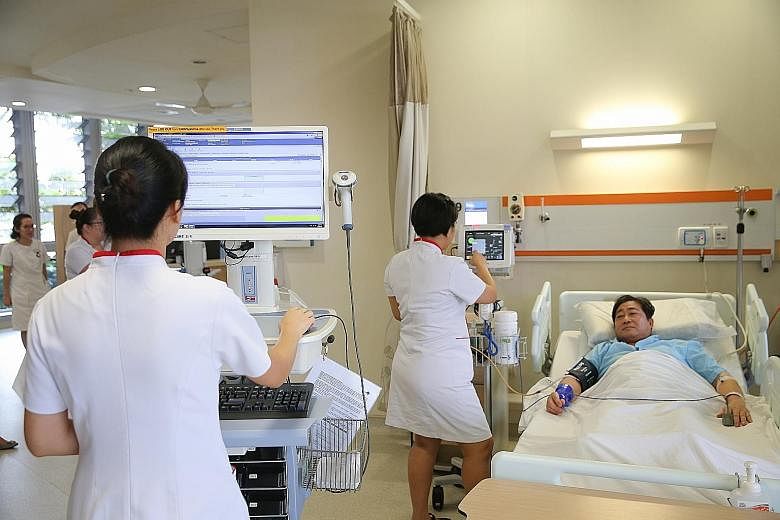Unless you were a patient of the Ng Teng Fong General Hospital, it might have escaped your notice that the hospital has surged ahead of the pack in one respect - becoming almost 99 per cent paperless since it opened in July 2015.
From patient information and the monitoring of vital statistics to drug dispensing at the correct dosage and timing, all data flows seamlessly through the acute hospital's electronic medical record system.
The exceptions are some hospital operations that still require paper, such as medical certificates and when the hospital communicates with third parties such as patients' employers.
It is believed to be the only public hospital in Singapore to have such an extensive paperless system.
While other hospitals here also have their own electronic medical record systems, some data is still recorded by staff on paper and manually keyed into the system.
The benefits of going paperless have far outweighed the costs, said Dr Gamaliel Tan, the hospital's chief medical informatics officer.
For example, patients are saved the pain and costs of repeated blood extractions, as the electronic medical record system will automatically suggest to staff that a repeat blood test be done on a blood sample that had been taken earlier.
-
3k
Number of nursing care hours saved each month, as nurses do not have to record information from the vital signs monitors - it is transmitted directly into the electronic medical record system.
This has cut the number of blood extractions by more than 1,000 every month, which translates to savings of about $21,000 for patients.
In addition, more than 3,000 hours of nursing care is saved each month as nurses do not have to record information from the vital signs monitors - it is transmitted directly to the electronic medical record system.
Eliminating the need to print electrocardiogram (ECG) reports also saved the hospital $150,000 from July 2015 to January this year.
The 700-bed hospital received the highest accreditation - Stage 7 - in September last year under global healthcare adviser HIMSS Analytics' Electronic Medical Record Adoption Model, which scores hospitals around the world based on their electronic medical record capabilities.
"There are productivity, efficiency, safety and financial benefits," said Dr Tan. "It is great for research too, because all your data is in the system."
Being a "greenfield hospital" that had to build up its own systems - it was managed at the start by Jurong Health Services, a regional health group that was formed in 2009 - and having staff who are open to change and innovation have been key factors in the successful execution of the system, he added.
Jurong Health Services is now a member of the National University Health System, after major restructuring by the Health Ministry to reshape the six regional health groups into three integrated clusters.
However, going paperless is not without its challenges.
"Before the system went live, the challenge was getting user requirements, making sure that people can agree on a certain workflow, building the workflow, then training them to use that workflow," said Dr Tan.
Doctors had to be trained four to six hours to use the electronic medical record system, while training for nursing staff took about a day.
Some hospital operations still require paper, too, such as medical certificates, hospital bills, receipts, and when the hospital communicates with third parties such as general practitioners, insurance companies and patients' employers.
Going forward, Dr Tan said, the hospital will look at how to better optimise the system, for example, by concentrating on different areas such as community care, integration with general practitioners and analytics.
The hospital is exploring how to use the record system to ensure surgical procedures start on time by tracking start times and prompting patients to be punctual, as well as a patient portal where patients will be able to change appointments and see their laboratory test results.
With all the data in one system, there are security protocols in place to ensure that it is "constantly guarded against cyberthreats", said Mr Lim Soo Tong, chief information officer for Ng Teng Fong General Hospital and Jurong Community Hospital.
These include data encryption, strict log-in and access control, and hardware and network protection with a multi-level firewall.
Other healthcare institutions here which are close to becoming paperless are the Institute of Mental Health (IMH) and the National Heart Centre Singapore (NHCS).
IMH is about 90 per cent paperless, which has helped in minimising miscommunication, improving the use of manpower and patient safety, as well as raising the quality of care, said Dr Eu Pui Wai, the institute's chief medical information officer.
Meanwhile, NHCS is close to converting all its outpatient clinical documents into electronic records and started doing the same for inpatient clinical notes less than a year ago, said its medical director, Professor Terrance Chua.


